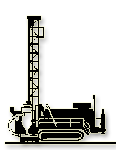Routine Maintenance will insure that your Filter/Clone® Dust Collector is operating to its design specifications.

Perform the following visual inspections on a periodic basis.
A. Verify that the dropout hose located at the bottom of the dust collector is securely fastened to the dropout chute. This hose should be free of any holes and should form a tight seal during the period when the collector is pulling a vacuum. The hose will open when the collector is pulling a vacuum. The hose will open momentarily during each back–pulse of compressed air when the filter elements are being cleaned.
B. The suction hose leading from the pickup–pot to the collector should be clear of obstructions such as build–up of dirt or mud. There should be no kinks or extremely sharp bends in the suction hose.
C. Inspect the pickup–pot area to confirm the integrity of the pipe seal and the rubber intake cone attached to the bottom of the pot. If your system is equipped for dust only collection, special attention should be paid to leaks in the dust curtain surrounding the hole.
D. Listen to the back–pulsing of the filter elements. There should be a sharp pulse of air every 3–4 seconds. If a pressure gage is installed in the air supply line to the collector, verify that the air is pulsed at a peak pressure of approximately 40 PSI.
E. Observe the discharge of the blower assembly. There should be no visible dust emerging from the outlet of the blower housing. If there is, the filter elements and/or filter gaskets should be replaced immediately to avoid damage to the blower wheel.
F. The filters should be cleaned whenever possible by pulsing the elements with the blower system turned off. This can be done at the end of any drilling cycle, while changing drill pipe sections, and possibly between each hole.
Please refer to the Service Manual and specific equipment detail on the Download page for additional data.
Contact Joe Tipton, Inc. or a Dealer in your area for questions about a Filter/Clone® Dust Collector.
